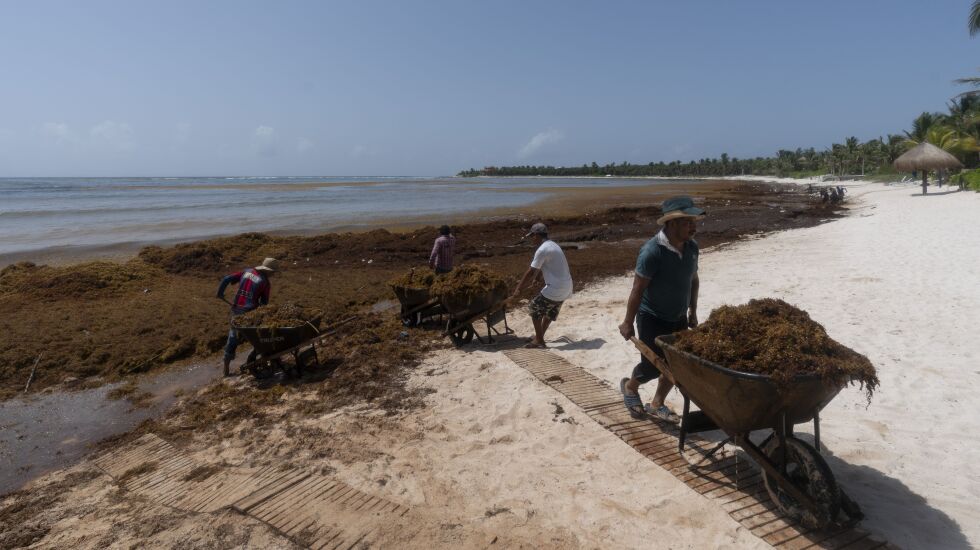
TULUM, Mexico — Scraping the smelly sargassum seaweed off some beaches on Mexico’s resort-studded Caribbean coast has become not only a nightmare but also possibly a health threat for the workers doing it — with mountains of the stuff washing ashore this year.
Sargassum is a kind of algae. When it decomposes, it generates hydrogen sulfide gas. In small amounts in open areas, it’s not much more than an annoying odor: sulfurous, like rotting eggs.
But in the quantities seen in once-paradisical beach towns like Playa del Carmen, Tulum and Xcalak, scientists say it can be dangerous to workers with respiratory problems as, maskless, they rake up the seaweed in the scorching heat.
This year appears on track to be worse than even the peak sargassum year of 2018.
Ezequiel Martínez Lara is one of thousands of laborers who work six to eight hours a day using pitchforks to heave mounds of sargassum into wheelbarrows, then wheeling them off the beach to a nearby street.
Martínez Lara used to make as much as $50 a day guiding sports fishermen. Now, he makes less than half that for collecting about 40 wheelbarrows of sargassum every day.
“If we clean it all off today, tomorrow more will have washed in,” said another worker, Austin Valle.
Workers like Martínez and Valle are exposing themselves to more than just the burning sun, according to Rosa Rodríguez Martínez, a biologist in the beachside town of Puerto Morelos who studies reefs and coastal ecosystems for Mexico’s National Autonomous University.
“At the university, we have started to measure the quantity of gases that sargassum produces when it is scraped up,” Rodríguez Martínez said. “At one spot, it reached 56 parts per million. That’s very high. Above two, that can be dangerous for people with respiratory problems.”
Saying she felt at risk just being there, “I took off running,” she said.
But Martínez Lara doesn’t have the luxury of avoiding the hydrogen sulfide gas. Like almost every other sargassum worker on the coast, he has no mask, gas sensor or medical care. He works at a day rate for the person who owns the house in front of the beach.
“When sargassum rots, it gives off a very strong odor, like acid, and it is very bothersome when you breath it; it hurts a lot,” Martínez Lara said.
A 2019 article in the Journal of Travel Medicine warned: “More chronic exposure to these gasses can lead to conjunctival and neurocognitive symptoms such as memory loss and impaired balance, as well as non-specific symptoms such as headache, nausea and fatigue.”
Contrary to that view, the Florida Health Department says, “Hydrogen sulfide levels in an area like the beach, where large amounts of air flow can dilute levels, is not expected to harm health.”
The sargassum problem isn’t as bad for tourists as it is for workers. Ligia Collado-Vides, a marine botanist at Florida International University who specializes in studying macroalgae like sargassum, said, “If you’re swimming for a little bit, it shouldn’t be a danger at all,” but added that tiny jellyfish cousins known as hydrozoa often inhabit sargassum mats.
“If you’re going to be there for a long time playing in the sargassum, you can get like many, many, many stings from hydrozoans, and those are toxic,” she said.
On a recent day, Sarah Callaway, a tourist from Denver, was pretty much confined to playing with her kids in the pool in front of their rented beach house.
“The property is beautiful, but we were automatically struck ... by the smell,” Callaway said.
Hundreds of thousands of people migrated to the coast in recent years for jobs catering to tourists like Callaway, but some are considering leaving.
The Caribbean coast suffered a drop in visits during the coronavirus pandemic, but, because Mexico never declared travel restrictions, testing requirements or mandatory mask rules, Americans have continued to come.
International tourism to the country surpassed pre-pandemic levels in the first half of 2022, with 10.26 million visitors from January to June — up 1.5% over the first half of 2019.
Mexico’s strongest showing was with U.S. tourists, with the number arriving by air in the first six months of 2022 at 6.66 million — up 19.1% over 2019.
Overall tourist spending remains below pre-pandemic levels.
Some of the most-developed resort areas, like Cancun, haven’t suffered as much from sargassum as lower-key resorts farther south, like Playa del Carmen and Tulum.
Sargassum is a threat to seagrass, fish and other marine life suffocated by the seaweed that drops to the bottom, decomposes and creates oxygen-depleted dead zones.
Recounting a recent monitoring expedition, Collado-Vides said: “It’s really terrible ... the amount of vertebrates, the amount of crabs, the amount of fish dead in just a one-square-meter quadrant.”







